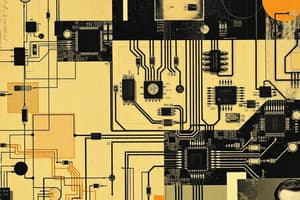Podcast
Questions and Answers
What method is used to write data to a device in I2C protocol?
What method is used to write data to a device in I2C protocol?
- transfer
- read
- send
- write (correct)
What is the purpose of the acknowledgment bit in I2C protocol?
What is the purpose of the acknowledgment bit in I2C protocol?
- To indicate that the receiving device has received the data (correct)
- To initiate the transfer of data
- To terminate the transfer of data
- To synchronize the clock signals of devices
What is the benefit of repeated start conditions in I2C protocol?
What is the benefit of repeated start conditions in I2C protocol?
- To increase the speed of data transfer
- To reduce the number of start and stop conditions (correct)
- To allow for simultaneous transfer of data
- To improve the reliability of data transfer
What is the purpose of the error handling mechanism in I2C protocol?
What is the purpose of the error handling mechanism in I2C protocol?
What is the role of the transmitter in I2C protocol?
What is the role of the transmitter in I2C protocol?
What is the role of the receiver in I2C protocol?
What is the role of the receiver in I2C protocol?
What is the term for a device that initiates and terminates transfers in I2C protocol?
What is the term for a device that initiates and terminates transfers in I2C protocol?
What is the purpose of arbitration in I2C protocol?
What is the purpose of arbitration in I2C protocol?
What is the term for a situation where more than one master can control the bus at the same time in I2C protocol?
What is the term for a situation where more than one master can control the bus at the same time in I2C protocol?
Flashcards are hidden until you start studying
Study Notes
Serial Communication Overview
- Serial communication: information is transmitted serially (bit-by-bit) over the communication medium
- Parallel communication: information is transferred in chunks of bits (bytes, 32-bit, 64-bit words) at a time
- Synchronous communication: transmission requires a reference clock
- Asynchronous communication: no reference clock, hand-shaking is required
I2C Serial Communications Protocol
- I2C is a two-wire serial communication protocol invented by Philips Semiconductors (now NXP) in 1982
- I2C connects microcontroller master devices with lower-speed peripheral slave devices
- Only two lines are used: Serial Data Line (SDA) and Serial Clock Line (SCL)
- Communication occurs in a synchronous, half-duplex manner
I2C Bus Overview
- I2C bus is a multi-master serial single-ended computer bus to communicate with low-voltage devices
- The I2C bus offers four data transfer speeds: standard, fast, high-speed, ultra high-speed modes
- I2C supports 7-bit and 10-bit address space devices and its operation varies with low voltages
- The I2C protocol connects a maximum of 128 devices
I2C Communication Modes
- Standard Mode: Up to 100 kbps
- Fast Mode: Up to 400 kbps
- Fast Mode Plus: Up to 1 Mbps
- High-Speed Mode: Up to 3.4 Mbps
- Ultra-Fast Mode: Up to 5 Mbps
I2C Protocol - Communication Steps
- Start Condition: Master initiates communication
- Address + Read/Write Bit: Master sends the slave’s address
- Data Transfer: Master writes or reads data
- Stop Condition: Master ends communication
I2C Message Format
- Message-oriented data transfer with four parts:
- Start condition
- Slave Address transmission
- Data fields
- Stop condition
Read/Write Control
- Start Condition: SDA goes from High to Low, while SCL is High
- Direction of Transfer:
- 𝑅𝑅|𝑤𝑤 = 0: Controller (Master) sending data to peripheral
- 𝑅𝑅|𝑤𝑤 = 1: Controller is requesting to receive data from peripheral
mbed Code Example: Reading Sensor Data
- Initialization: Create an instance of the I2C object and specify the pins for SCL and SDA lines
- Addressing: Specify the address of the device to communicate with
- Reading and Writing: Use the "read" and "write" methods to communicate with the device
- Acknowledgment: Receiving device sends an acknowledgment bit after each byte of data is transferred
- Repeated Start: Allows for repeated start conditions for reading or writing multiple registers
- Error Handling: Mbed provides methods for error handling, including timeouts and retries
I2C Terminology
- Transmitter: The device that sends data to the I2C bus
- Receiver: The device that receives data from the I2C bus
- Controller (Master): The device that initiates/terminates transfers and generates clock signals
- Peripheral (Slave): The device addressed by a master
- Multi-Master: More than one master can control the bus at the same time without corrupting the message
- Arbitration: Procedure to ensure that only one master controls the bus at a time
- Synchronization: Procedure to synchronize the clock signals of two or more devices
Studying That Suits You
Use AI to generate personalized quizzes and flashcards to suit your learning preferences.



